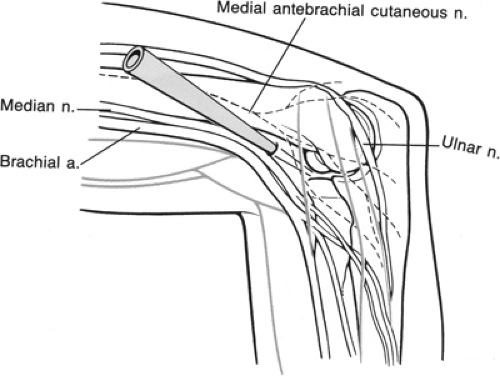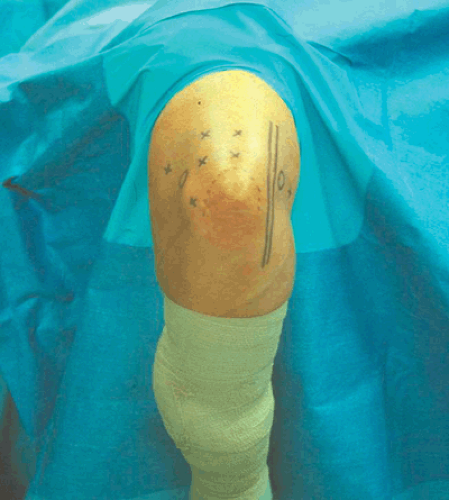Diagnostic Arthroscopy and Loose Body Removal
Glen A. McClung MD
Larry D. Field MD
Felix H. Savoie III MD
History of the Technique
In 1932 Michael Burman1 concluded that the elbow joint was “unsuitable for examination” arthroscopically. Since that time advances in arthroscopy and equipment have made elbow arthroscopy safe and effective in the management of a variety of elbow disorders. Elbow arthroscopy is a technically demanding procedure that requires a thorough knowledge of the neurovascular anatomy of the elbow. The original indications for elbow arthroscopy only included the diagnosis and removal of loose bodies. As techniques have advanced, the indications for elbow arthroscopy have expanded to include the treatment of synovitis, osteochondritis dissecans, capsular contractures, arthritis, fractures, lateral epicondylitis, and instability.2,3,4,5
Elbow arthroscopy was originally performed with the patient in the supine position and the hand suspended to traction. Because of poor access to the posterior aspect of the elbow, Poehling et al.6 popularized the prone position for elbow arthroscopy. The lateral decubitus position has been advocated by O’Driscoll and Morrey.3 The arm is positioned with the involved side up, the elbow flexed at 90 degrees, and the arm supported by a padded bolster. This position allows better access to both anterior and posterior compartments.
Indications and Contraindications
The indications for elbow arthroscopy include the removal of loose bodies,2,7,8,9,10,11,12 removal of osteophytes secondary to osteoarthritis,13,14 radial head resection,15 release of capsular contractures and adhesions,16,17 and the resection of symptomatic plica.18,19 Other indications include the treatment of osteochondritis dissecans,2,20,21,22 fractures,2,23,24 lateral epicondylitis,25,26 instability,27 septic arthritis,5 synovectomy,5,23 and evaluation of patients with chronic elbow pain.2
Multiple studies have demonstrated the effectiveness of elbow arthroscopy for the diagnosis and treatment of loose bodies. Success rates have been reported in the 90% range.7,8,10,11 Elbow arthroscopy for loose bodies is indicated in symptomatic patients who fail to respond to conservative treatment. The operating surgeon should attempt to determine the etiology of the loose body. Loose bodies are often a result of osteochondritis dissecans. Other causes include trauma, arthritis, or synovial osteochondromatosis. It is essential that the operating surgeon determine the source of loose bodies, since the outcome of the patient will be determined by the disease, not just the removal of loose fragments.22
Prior to taking a patient to the operating room for the removal of loose bodies, a careful history and physical examination must be performed. A history of prior surgeries should be obtained, particularly those involving release or transposition of the ulnar nerve. Physical examination should include range of motion, stability, and neurovascular exam. The ulnar nerve should be evaluated during elbow flexion to ascertain subluxation or dislocation of the nerve. Loose bodies are commonly located in the coronoid fossa, the olecranon fossa, and the posterior lateral gutter, and access to these sites must be obtainable by the surgeon. A complete and thorough evaluation of the joint is necessary because loose bodies can migrate to any area of the elbow.
Portals
A thorough knowledge of the neurovascular anatomy of the elbow and its three-dimensional relationship to the surface
anatomy is required to perform elbow arthroscopy. There are eight access portals that are utilized in elbow arthroscopy. These are determined by neurovascular and musculotendinous anatomy about the elbow. Arthroscopic treatment of the elbow may require the use of several of these portals since the elbow is a highly constrained joint. As the complexity of arthroscopic procedures of the elbow have increased, the number of portals utilized have also increased with an emphasis on the proximal anterior portals.
anatomy is required to perform elbow arthroscopy. There are eight access portals that are utilized in elbow arthroscopy. These are determined by neurovascular and musculotendinous anatomy about the elbow. Arthroscopic treatment of the elbow may require the use of several of these portals since the elbow is a highly constrained joint. As the complexity of arthroscopic procedures of the elbow have increased, the number of portals utilized have also increased with an emphasis on the proximal anterior portals.
Surface landmarks are marked on the skin prior to creating portals (Fig. 22-1). Important landmarks to outline are the radial head, olecranon, lateral epicondyle, medial epicondyle, and ulnar nerve. Prior to making portals, the joint must be distended with 20 to 30 ml of sterile saline. This can be done by placing an 18-guage spinal needle either in the olecranon fossa or the soft spot bounded by the lateral epicondyle, olecranon, and radial head. Neurovascular structures are displaced away from the joint with distention of the joint, which gives an additional margin of safety.28,29
Poehling et al.6 first described the proximal anteromedial portal in 1989. This portal is located 2 cm proximal to the medial epicondyle and just anterior to the medial intermuscular septum (Fig. 22-2). The medial intermuscular septum is identified by palpation, and the portal is made anterior to the septum so that the ulnar nerve is not injured. The blunt trocar is introduced into the portal, anterior to the septum, and aimed toward the radial head while maintaining contact with the anterior surface of the humerus. This allows the brachialis muscle to remain anterior and protect the median nerve and brachial artery. The trocar enters the elbow through the tendinous origin of the flexor-pronator group and medial capsule.30
 Fig. 22-2. The proximal anterior-medial portal located approximately 2 cm’s superior and 2 cm’s anterior to the medial epicondyle is marked along with relevant neurovascular structures. |
The proximal anteromedial portal has been recommended as the initial portal utilized with the patient in the prone or lateral decubitus position.6,28 This portal is thought to offer safer access and better visualization of the joint. In addition, fluid extravasation may be less with this portal compared to the anterolateral portal.28 Visualization of the entire anterior aspect of the joint including the anterior capsule, trochlea, capitellum, coronoid process, radial head, and medial and lateral gutters can be obtained with this portal.
The primary structure at risk with this portal is the posterior branch of the medial antebrachial cutaneous nerve.31 This nerve is located approximately 2.3 mm from the trocar. With the elbow in flexion, the median nerve is relatively safe, protected by the brachialis muscle, being located on average a distance of 12.4 to 22 mm from the trocar.28,31 The path of the trocar aims distally and is in a parallel orientation to the median nerve, making injury to the nerve less likely. The ulnar nerve is located on average a distance of 12 to 23.7 mm from the portal.28,31 The ulnar nerve is not at risk as long as the portal is made anterior to the intermuscular septum. Contraindications to the use of this portal are a history of subluxation or transposition of the ulnar nerve from its groove.28,31,32 Care must be taken to ensure that the ulnar nerve is not subluxed prior to anteromedial portal placement. This portal may be used in these circumstances only if the nerve is identified prior to trocar entry.
The anteromedial portal, first described by Andrews and Carson,23 is positioned 2 cm distal and 2 cm anterior to the medial epicondyle (Fig. 22-3). With the elbow flexed to 90 degrees, the blunt trocar is aimed at the center of the joint, passing through the flexor-pronator origin and the brachialis muscle before entering the joint capsule anterior to the medial collateral ligament. This portal may also be established by using an inside-out technique with the arthroscope
in the lateral portal.28 The entire anterior compartment of the elbow can be visualized from this portal, especially the lateral structures. The medial antebrachial cutaneous nerve is at greatest risk of being injured, located on average 1 mm from the portal.31 The median nerve is in closer proximity to this portal, being located on average a distance of 7 to 14 mm.29,31 Lindenfeld28 reports an average distance of 22 mm from the portal to the median nerve if this portal is established 1 cm anterior to the medial epicondyle.
in the lateral portal.28 The entire anterior compartment of the elbow can be visualized from this portal, especially the lateral structures. The medial antebrachial cutaneous nerve is at greatest risk of being injured, located on average 1 mm from the portal.31 The median nerve is in closer proximity to this portal, being located on average a distance of 7 to 14 mm.29,31 Lindenfeld28 reports an average distance of 22 mm from the portal to the median nerve if this portal is established 1 cm anterior to the medial epicondyle.
Stay updated, free articles. Join our Telegram channel

Full access? Get Clinical Tree









